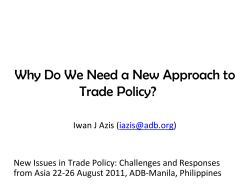
Economies and Diseconomies of Scale AS Economics tutor2u™
Economies and Diseconomies of Scale AS Economics tutor2u™ Key Issues • Long run production • Economies of scale • Economies of scope • Benefits of economies of scale for consumers and producers • Economies of scale and the development of monopoly power in a market • Possible causes of diseconomies of scale tutor2u™ Returns to Scale in Long run Production • Increasing returns to scale – When the % change in output > % change in inputs – E.g. a 30% rise in factor inputs leads to a 50% rise in output – Long run average cost will be falling tutor2u™ Returns to Scale in Long run Production • Decreasing returns to scale – When the % change in output < % change in inputs – E.g when a 60% rise in factor inputs raises output by only 20% – Long run average cost will be rising tutor2u™ Returns to Scale in Long run Production • Constant returns to scale – When the % change in output = % change in inputs – E.g when a 10% increase in all factor inputs leads to a 10% rise in total output – Long run average cost will be constant tutor2u™ Changing the scale of production tutor2u™ Internal Economies of Scale • Technical Economies of Scale – The Law of Increased Dimensions • Cubic law can be applied where cubic volume increases more than proportionate to surface area – Economies of linked processes • Production processes can linked together with one integrated plant – important in mass production which requires complex manufacturing processes tutor2u™ Internal Economies of Scale – Large-scale indivisible units of capital machinery • Capable of high productivity (e.g. presses used in the manufacture of steel products) • Huge units of capital require a vast output in order to reduce the average cost per unit – Specialisation and Division of Labour • Breaking down the production process into many small tasks tutor2u™ Scale Economies Continued • Marketing Economies • Expensive advertising spending can be spread over huge volumes of sales – reduces the marketing costs per unit • Risk-Bearing Economies (lower risks) • Diversification of products – growth of multi-product firms • Diversification of plant locations / retail outlets – including the expansion of multinational business tutor2u™ ARLA dairy at Lockerbie, Scotland tutor2u™ Scale Economies continued • Financial Economies – Bulk purchasing economies • Monopsony power of buyers of components) – Access to cheaper sources of finance • Lower interest rates for larger businesses • E.G. share issues and corporate bond finance • Learning Economies • Efficiencies due to the length of experience in a market • Readily available in high-knowledge industries • “Learning by doing” “Tricks of the trade” tutor2u™ The long run average cost curve ILLUSTRATING ECONOMIES AND DISECONOMIES OF SCALE Productive efficiency in the long run is achieved when output is produced at the bottom of the long run average cost curve Costs SRAC1 SRAC3 SRAC2 AC1 LRAC AC2 AC3 Q1 tutor2u™ Q2 Q3 Output (Q) Illustrating economies of scale Costs Revenues ECONOMIES OF SCALE ALLOW LOWER ATC, LOWER PRICES AND HIGHER PROFITS SRAC1 Economies of scale as a business achieves plant economies of scale and can move onto a lower average cost curve P1 SRAC2 P2 AC1 Demand AC2 Q1 tutor2u™ Q2 Quantity Produced (Q) Economies of Scope • Where it is cheaper to produce a range of products than to produce each individual product on its own • McDonalds hamburgers and french fries share the use of food storage and preparation facilities • Proctor & Gamble – P&G owns over 250 brands, including Pringles crisps, Crest toothpaste, Max Factor make up and Pampers nappies – Graphic designers and marketing experts can use their skills across hundreds of product lines • Car manufacturers – Car panels / interiors are common to a range of models • Airlines – If an airline has a hub and spoke network then adding one more route to its network creates many more potential transfer routes for the airlines customers tutor2u™ Limits to Economies of Scale • Limited total market demand for many products • Market demand may be insufficient for businesses to fully exploit the scale economies • “Niche markets” allow smaller-scale producers to supply at higher cost because consumers are willing to pay a higher price • In a recession - capital will be under-utilised leading to excess capacity and rising average total costs • Occupational immobility of capital equipment • Some large units of fixed capital may not be transferable to other uses if there is a switch in consumer demand. • Diseconomies of scale tutor2u™ • A business may expand beyond the optimal size in the long run and experience diseconomies of scale External Economies of Scale AS Economics tutor2u™ External Economies of Scale • External economies of scale exist when the longterm expansion of an industry leads to the development of ancillary services which benefit all or the majority of suppliers in the industry – A labour force skilled in the specific crafts of the industry – Components suppliers equipped to supply the right parts re-locate close to production centres – reducing transportation costs – Trade magazines in which all firms can advertise cheaply and disseminate information – Development of industry-specific research capabilities in local universities tutor2u™ External Economies of Scale (2) • External economies partially explain the tendency for firms to cluster geographically • Good examples to quote – Car industry in the West Midlands – Silicon Valley & its pool of computer experts – Financial services industry in London and New York tutor2u™ Diseconomies of Scale AS Economics tutor2u™ Diseconomies of Scale • Diseconomies of scale leads to rising long-run average costs – LRAC rises due to firms expanding beyond their optimum scale – Diseconomies are difficult to identify precisely • They are often caused by the complex nature of managing large-scale firms and in managing the growth of a business – (1) Costs of administration and coordination of the workforce – (2) The growth of corporate bureaucracy (i.e. which might be seen in excessive layers of management) – (3) The risk of worker alienation or shirking because of the problems in monitoring the effectiveness of workers – (4) Differences in the optimum scale of units of capital – (5) An increase in transportation costs to distant markets tutor2u™ External Diseconomies of Scale • These occur when too many firms have located in one area • Local labour becomes scarce and firms now have to bid wages higher to attract and retain new workers • Land and factories become scarce and rents begin to rise • The local traffic infrastructure become congested and so transport costs begin to rise tutor2u™
© Copyright 2025









